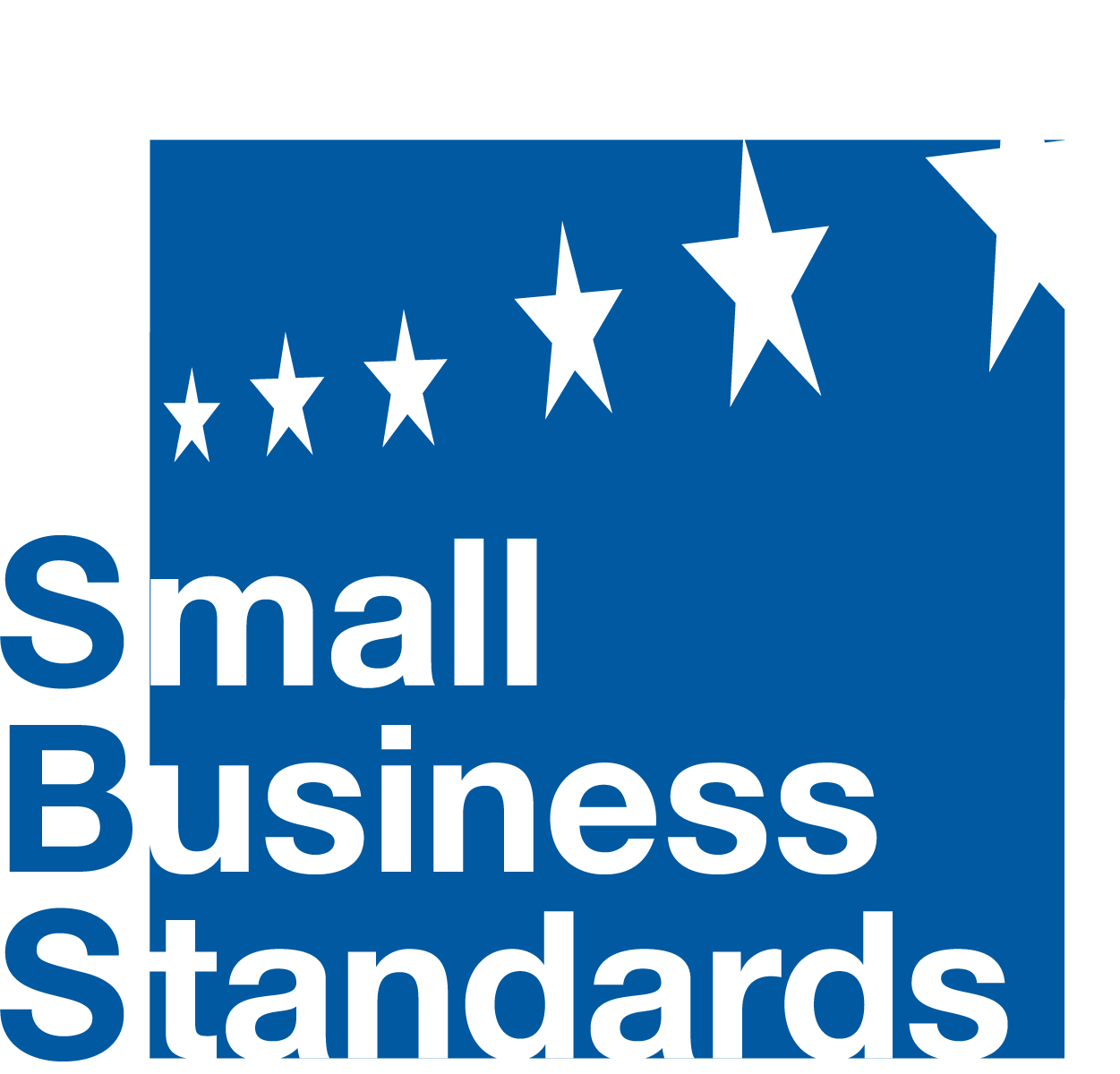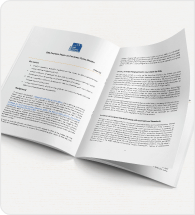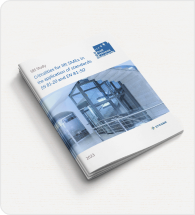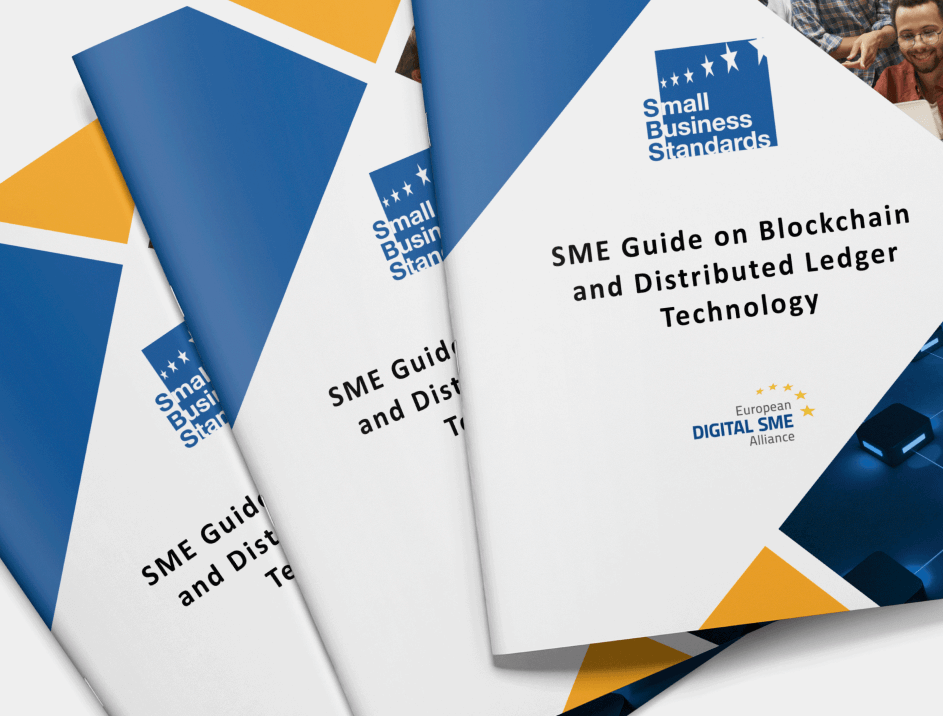Key points
• SBS understands the reason why the European Commission (EC) proposes to convert the Directive into a Regulation, as the conversion will increase legal certainty and allow SMEs and all stakeholders to follow the provisions of a single text, without having to adapt to 27 different national transposition laws. However, SBS is concerned that the introduction of a regulation that could not be fully tailored to the specificities and needs of SME will preclude individual States from adapting the text to the characteristics of SME, presenting them with difficult issues to deal with.
• SBS is concerned by the empowerment of the Commission to adopt new technical specifications, as described in Article 17.3 of the Regulation. The current provisions seem to be in conflict with the purported goal of aligning the new Machinery Regulation with the principles of the New Legislative Framework (NLF). NLF principles dictate that European legislation should define mandatory Essential Health and Safety Requirements (EHSRs), leaving the definition of technical details to meet these requirements to harmonised standards developed by stakeholders in line with the state of the art. Furthermore, in the current text there are no provisions to involve stakeholders and specifically SMEs in the process of adoption of said technical specification.
• SBS is troubled by the introduction of the concept of Substantial Modification, as set out in Definition 16 and in Article 15 of the proposal. The possibility for end users, the vast majority of which are SMEs, to modernise, update and upgrade existing machinery is a crucial element to their competitiveness. The Regulation should refrain from establishing any additional obligations to end users when upgrading their machines. In this sense, it must be highlighted that the 2016 Blue Guide on the implementation of EU product rules foresees that the revision of the Machinery Directive should not give rise to any additional obligations for end users.
•SBS welcomes the exclusion of means of transport on road from the scope of the Regulation, as outlined in Article 2.2(e) and calls upon the IMCO CommitteeI not to roll back this provision for light, electric vehicles such as e-bikes and e-scooters. This exclusion is essential to allow for electric cycles and light electric vehicles (LEVs) excluded from Regulation 168/2013 to realise their full potential and contribute to cutting GHG emissions. Exclusion of all vehicles from the Machinery legislation should be the only the first step towards the urgent development of effective, tailored European legislation for LEVs.
• SBS is concerned by certain aspects of the Regulation concerning Annex I (‘high-risk’) machinery. SBS strongly believes that the procedure to update and modify the list of machinery products included in the Annex should be more transparent and include all stakeholders, while at the moment the Regulation disciplines this process with via the creation of a committee that does not foresee inclusion or participation of stakeholders and specifically SMEs.
• SBS expresses concerns on the obligation to obtain third-party assessment for all products listed in Annex I. These concerns are twofold, as they involve both the increase in costs that will inevitably fall on SMEs and all stakeholders to comply with the new obligation and the justification to take such a measure, given that Commission sources themselves indicate that there is no tangible difference between self-assessment and third-party assessment as far as the safety of the machinery products put on the market is concerned. In order to deal with these concerns, SBS is in favour of maintaining the existing discipline for the conformity assessment of listed products, as set out in the Machinery Directive (Directive 2006/42/EC) according to Art. 7.2 and Art. 12.3.
• SBS supports the switch to digital formats for documentation, as it tangibly reduces administrative and environmental costs. At the same time, SBS also supports the provision to make a paper
version of the documentation mandatorily available upon request. SBS reminds that when considering the management of digital documentation for machinery products, the whole life cycle of the product and all stakeholders should be considered, fully taking into account the crucial role of SMEs in maintenance, servicing and all after-sale purposes.
Background
In April 2021 the European Commission published its proposal for a Revision of the Machinery Directive (Directive 2006/42/EC) and convert it into a Regulation. The new proposal pursues six main objectives, following to issues identified with the current legislation:
• Adapting to new technological developments;
• Clarifying scope and definitions;
• Re-evaluating the provisions on machines deemed “high-risk“;
• Curbing the financial and environmental costs linked to extensive paper-based documentation;
• Aligning with the New Legislative Framework;
• Converting the legislation into a Regulation, thus creating a single text and eliminating the
divergences due to the transposition of the Directive in the different Member States.
In the European Parliament the proposal is currently being discussed in the Committee on the Internal Market and Consumer Protection (IMCO), and on 20th October the Draft Report by Mr. Ivan Štefanec, MEP (EPP, SK) was published, with the vote on the Report in the IMCO Committee foreseen for March 2022.
This paper puts forward SBS’s position on the proposal for a Regulation. It is important to point out that the Machinery Directive covers a wide range of products, from agricultural and industrial machinery to slow speed lifts and electric furniture. SMEs represent the vast majority of stakeholders in all these sectors, as manufacturers, users and service providers. It is therefore of paramount importance that the Regulation fully takes into account the needs and the possible effects of the legislation on SMEs across all affected sectors and at all levels of the value chain.
Choice of Legal Instrument
SBS understands the reason why the EC proposes to convert the Directive into a Regulation, as the conversion will increase legal certainty and allow SMEs and all stakeholders to follow the provisions of a single text, without having to adapt to 27 different national transposition laws. However, SBS is concerned that the introduction of a regulation that could not be fully tailored to the specificities and needs of SME will preclude individual States from adapting the text to the characteristics of SME, presenting them with difficult issues to deal with.
Empowerment of the Commission to adopt Technical Specifications – Art. 17.3
SBS is concerned by the proposal to empower the Commission to adopt implementing acts establishing technical specifications to meet the Essential Health and Safety Requirements (EHSRs) of the future Regulation (Article 17.3). This seems to be in conflict with one of the main objectives of the review of the Machinery Directive, which is to align the new Machinery Regulation with the provisions of the New Legislative Framework (NLF) in line with Decision 768/2008/EC.
The NLF principles dictate that European legislation defines mandatory Essential Health and Safety Requirements, leaving the definition of technical details to meet these requirements to harmonised standards developed by stakeholders in line with the state-of-the-art and duly implementing all the relevant EHSRs. This approach establishes clear roles and responsibilities and has been central to the achievements of the Single Market and the setup of a flexible framework that allows to cope with technological developments.
While SBS is opposed in principle to the empowerment of the Commission to adopt technical specifications, it acknowledges the possibility to have a backstop measure to do so in case standards are not available. However, it should be absolutely clear in the text that such a step would have to be taken exclusively as a last resort and after having exhausted all other alternatives. To further underline this point, SBS supports IMCO Amendment 19 to Recital 40 of the text.
More specifically, the wording used in Article 17.3 (b) of the Regulation, “undue delays in the standardisation procedure” as a condition to allow the Commission to adopt implementing acts does not in fact provide any kind of timeline or factual circumstances for this power to be exercised. In order to achieve clarity and transparency on this point, SBS supports the spirit of IMCO Amendment 242 and invites the members of the IMCO Committee to reformulate it as follows, in order to avoid loopholes and inconsistencies:
• “… the requested standard has not been developed within a minimum of 5 years following the standardisation request, or within the duration of the standardisation request, should that be
longer than 5 years or the request has not been accepted by any of the European standardisation organisations.”
In any case, this possibility for the Commission should be designed so that stakeholders will have to be involved in the process. In this sense, SBS calls for a new specific provision that disciplines an inclusive involvement and role of stakeholders, including SMEs, in the adoption of technical specifications by the Commission, to be added at the end of Article 17.3 of the Regulation.
Substantial modification – Art. 3.16; Art. 15
The Regulation’s introduction of the concept of substantial modification as currently outlined in Definition 16 and in Article 15 of the proposal is a source of grave concern for SBS. The definition and idea of substantial modification set out in the text is clearly a hindrance to modernising, updating and upgrading existing machinery, which are crucial elements for all end users, but particularly for SMEs.
Article 15 of the Regulation states that “A natural or legal person, other than the manufacturer, the importer or the distributor, that carries out a substantial modification of the machinery product shall be considered a manufacturer for the purposes of this Regulation and shall be subject to the obligations of the manufacturer”. To equate SMEs and microenterprises to “full manufacturers” if they choose to upgrade their machinery will simply dissuade them from upgrading their equipment and hamper their competitiveness, since they cannot afford to buy new machines whenever they want to upgrade the performance or safety of their existing ones.
The current text of the Regulation would create an environment where the original manufacturers would obtain a de-facto monopoly on the modification of machines and force SMEs to buy new machines when they want to continue to use the ones in service by upgrading them. Disincentivising updating and upgrading of existing machinery and pushing SMEs and all economic actors towards buying new equipment is also clearly in contradiction with the European Commission priorities and objectives regarding circular economy and industrial green transition.
It must be pointed out that the current text directly contradicts the 2016 Blue Guide on the implementation of EU product rules, which clearly states that “Contrary to economic operators, end users are not defined in Union harmonisation legislation and are not subject to obligations”. Moreover, from our perspective modifications to machinery in service must remain regulated under the Work Equipment Directive (2009/104), as long as the machinery has not been made available again on the market. Otherwise, companies will be discouraged from modernising their machinery, including modifications aimed at improving the safety of their employees.
It is SBS’s opinion that the political and regulatory decisions consistently made so far by the Commission not to introduce further obligations for end users must be upheld and maintained, and that any notion of “substantial modification” in the Machinery Regulation should continue to follow in the same direction.
In order to address some of the aforementioned issues, SBS strongly supports IMCO Amendment 6 to, which adds the following criteria for a change to be identified as a “substantial modification”:
• “A change to the hardware or software in a machinery product might change its intended functions,
type or performance, which might change the nature of the hazard or increase the level of risk”.
Similarly, SBS strongly supports IMCO Amendment 19 to Article 3.1.16, which provides more clarity and balance to the definition of substantial modification by clearly stating that only changes where the modification factually affects the compliance of the product with the relevant EHSRs should fall under the definition of “substantial modification”. The current text of the Regulation, which extends the concept to any change that “may affect” the relevant EHSRs is unclear and does not provide SMEs and all stakeholders with the necessary legal certainty to safely and effectively carry out their activities.
On the same point, SBS also expresses its strong support for IMCO Amendments 175 and 178, which also provide more accurate and acceptable criteria to the definition on substantial modification. Conversely, on the same point SBS opposes IMCO Amendment 177.
Amendments 6, 19, 175 and 178 state that a modification must fundamentally change the purpose of the machine or lower the level of safety in order to fall under the definition of “substantial modification”. The lowering of the original safety level is an important criterion, because the Work Equipment Directive (2009/104) requires the employer to maintain the original safety level. The change of use of a machine is an extremely rare occurrence and SBS has no concerns on that specific point.
Furthermore, SBS calls for a further specific change to be made to the text of the Regulation, which is to exclude employer end users from the provisions of Article 15. In our view, this is the only way to avoid overlap between the future Regulation and the Work Equipment Directive (2009/104). Under Article 15 of the text, SBS also supports IMCO Amendments 230 and 231, provided that the aforementioned new criteria for definition of Substantial Modification are accepted and implemented.
Exclusion on the means of transport on road – Article 2
SBS welcomes the exclusion of light, electric vehicles (LEVs) from the Machinery Regulation and deeply regrets all IMCO amendments aimed at preventing such exclusion. This exclusion is essential to allow for electric cycles and LEVs in general to realise their full potential and contribute to cutting GHG emissions. The exclusion is further justified by the fact that Machinery legislation is not meant to regulate risks exclusively related to the transport of persons or goods.
Exclusion from the Machinery Regulation will not create a legal vacuum since the vehicles will temporarily come under the General Product Safety Directive. Manufacturers will be able to continue to use existing EU standards such as EN 15194:2017 and EN 17128:2018. For the LEV sector, where SMEs are a majority, it is important to be able to rely on standards to be able to put their products on the market. However, the harmonisation of these standards under the Machinery Directive is becoming increasingly difficult because the EHSRs have not been developed specifically for means of transport such as LEVs.
As things stand, both the Machinery Directive and Regulation 168/2013 prove to be inadequate for LEVs, and the development of a horizontal legal text with general safety requirements for means of transport not subject to type-approval complemented with harmonised standards is by far the preferable option. In a recent study on 2 and 3-wheel vehicles, quadricycles and Personal Mobility Devices (PMDs), carried out at the request of the European Commission the conclusion is that “a dedicated system for the harmonised approval of PMDs that is separate from both Regulation (EU) No 168/2013 and the Machinery Directive” is the preferred way forward. Therefore, the exclusion of LEVs from the Machinery Regulation should be only the first step towards the development of effective, tailored European legislation on LEVs. SBS calls for the European Commission to urgently take such a step and propose as soon as possible a new proposal for legislation specifically covering LEVs.
In order to maintain the exclusion of LEVs from the text of the Machinery Regulation and allow the European Commission to urgently move towards proposing new targeted legislation covering LEVs, SBS strongly opposes IMCO Amendment 2 and any further amendment proposed in the Committee (IMCO Amendment 105 and others), which rolls back the proposed exclusion.
High-risk machinery products, Risk Assessment and relation with AI Regulation
SBS is concerned with certain aspects of the Regulation concerning Annex I (‘high-risk’) machinery. SBS strongly believes that the procedure to update and modify the list of machinery products included in the Annex should be transparent and include stakeholders. In Articles 45.3 and 46.1 of the Regulation, the procedure is disciplined via the creation of a Committee that “shall consult experts nominated by each Member State”. It is concerning that such a setup would not include representation from all stakeholders involved. Such a system would be particularly harmful for SMEs, which would be at a significant disadvantage with regards to expressing their positions and having their voices heard.
In this sense, SBS calls for a provision to be added under the Article 5.2 of the Regulation, setting out a clear and transparent procedure for an inclusive stakeholder involvement on any initiative amending Annex I to the Regulation. In this sense, SBS strongly supports IMCO Amendments 129 and 197.
Furthermore, the high-risk sectors as currently set out in the Regulation should be revised, as they include AI applications that do not have a direct impact for the public, for citizens, or for customers or are common practice, according to the criteria and considerations laid out in Article 5.3 of the Regulation.
With reference to Recital 71 and Article 10.3 of the proposal, SBS also stresses the importance of effective and transparent data access throughout the value chain and the life cycle of the product. Particularly in certain sectors where SMEs have an overwhelming market share in maintenance, upgrading and all aftersale services. While safety is obviously a paramount consideration for all stakeholders throughout the value chain, it cannot and must not be used as a crutch by large manufacturers to create a closed shop and lock SMEs and other stakeholders out of their roles and opportunities throughout the value chain. These considerations also extend to software and cybersecurity, where the relevant authorities should remain vigilant that the use of proprietary security systems by large manufacturers or providers does not create a closed-shop situation in the after-sale phases. Any unjustified restriction to a safe and transparent circulation of data would artificially create a market imbalance, damaging innovation and the involvement of economic actors, particularly SMEs, at all levels of the value chain.
In this sense, safe and transparent access in “Read-only mode” to the data produced by the machinery products during their operation (including between interested third party operators) should be granted, under the consent of the owner of the machine. Such access should always respect and adhere to security and privacy provisions identified under the Radio Equipment Directive (RED) 2014/53/EU.
SBS supports the text of Annex III point 1.1.9 – “Protection against corruption”. It is particularly important that machinery products connected either directly or remotely to other devices are designed and constructed to avoid hazardous situations and accidental or malicious corruption. It is also important that the machinery product should identify, track and log all interventions to the hardware and software components that are critical to the machinery’s compliance with the relevant health and safety requirements. Therefore, SBS opposes several IMCO Amendments (351, 355 and others) that either severely weaken this provision or delete it altogether from the text.
With regards to references to cybersecurity (Point 5.2 of the Exploratory Memorandum and Article 17.5 among others), SBS believes that this is an area that requires more in-depth analysis, and SBS may follow up in the near future with a specific document addressing cybersecurity concerns horizontally, commenting on different pieces of relevant European legislation.
Conformity Assessment – Article 5.1; Article 21.2
While SBS fully supports carrying out scrupulous and transparent conformity assessment procedures on all machinery put on the market, there are reasons for concern that stem from the decision to establish a mandatory third-party assessment for all machinery listed in Annex I even when manufacturers can apply harmonised standards covering all the relevant EHSRs. SBS believes that SMEs and companies in general should have the possibility to rely on harmonised standards to assess the conformity of their products with the requirements of the Regulation.
The issue of increased costs should be considered first. The new obligation for manufacturers to seek thirdparty conformity assessment for all Annex I products would inevitably lead to significant additional costs. These additional costs would be particularly impactful for SMEs and in the production of small series of specialised products, which are often manufactured by highly innovative SMEs. In any case in which thirdparty assessment should be sought, it is necessary that the needs and specificities of SMEs are taken into account. Therefore, SBS opposes IMCO Amendment 265, which deletes the proportional reduction of third-party assessment fees for SMEs.
Furthermore, it is fair to question whether such a measure would actually improve at all the safety of the machinery put on the market. The Commission itself, in the 2018 Evaluation of the Machinery Directive, highlights that there is not always a tangible difference of effectiveness between self-assessment and thirdparty assessment. To the contrary, Commission findings indicate that “third party involvement does not always guarantee the reassurance, which the manufacturers are seeking and that it is not more effective in terms of ensuring safety protection than internal production control” and that “the number of technical non-conformities detected was significantly higher for products subject to EC type-examination than for products subject to self-assessment”.
In order to address these concerns, SBS is in favour of maintaining the existing discipline for the conformity assessment of listed products, as laid out in the current text of the Machinery Directive (Directive 2006/42/EC) according to Art. 7.2 and Art. 12.3. In this way, “Machinery manufactured in conformity with a harmonised standard, the references to which have been published in the Official Journal of the European Union, shall be presumed to comply with the essential health and safety requirements covered by such a harmonised standard”, leaving open the opportunity for manufacturers to carry out the conformity assessment procedure internally, according to the procedure laid out in Article 12.3(a), “where the machinery is manufactured in accordance with the harmonised standards referred to in Article 7(2), and provided that those standards cover all of the relevant essential health and safety requirements“.
Digital documentation – Art. 22.1 and others
SBS supports allowing a digital format for documentation, thusreducing administrative and environmental costs. SBS also is in favour of the provision to make a paper version of the documentation mandatorily available upon request.
Any transition towards digital documentation should be progressive and bear in mind the specificities of SMEs and microenterprises, their needs and their capacity to adapt. These aspects include, but they’re not only limited to, digital literacy and time and manpower constraints. In this sense, SBS supports IMCO Amendment 387, which reinforces the provision for documentation to be provided in paper format free of charge for up to five years after the purchase of the machinery. SBS remarks that it should be ensured that the relevant digital documentation remains downloadable and available for the whole life cycle of the product. In order to achieve this, SBS supports IMCO Amendment 391.
Particularly in sectors in which periodic checks or verifications, including at the national level, may need to be carried out, it would be useful to collect all the necessary information and instructions in an easily accessible centralised database. This would greatly facilitate the availability of the necessary information and the market surveillance for the whole life cycle of these products, which need to be kept in safe operating order for the benefit of their users as well as helping to prevent problems or lack of access in cases of manufacturer bankruptcy or change in data format. SBS remarks that any system to manage digital documentation for machinery should carefully consider the crucial role of SMEs in maintenance, servicing
and for all after-sale purposes.
SBS also would like to stress the importance ofscrupulously and reliably trace, date and log any update or modification to the digital documentation, in order to avoid any lack of clarity or transparency and offer guarantees to all involved parties, particularly in cases involving legal liability.
In conclusion, a final linguistic point should be made. Particularly considering the fact the Commission is proposing to use the instrument of the Regulation, it is of paramount importance to avoid lack of clarity or loopholes that the legal text, once approved, is translated into all EU official languages while staying as close as possible to the letter, definitions and interpretations provided in the original English text. Therefore, an effort should be made to solve or clarify the translation issues that have already been raised by several stakeholders with regards to the text of the proposal.



























